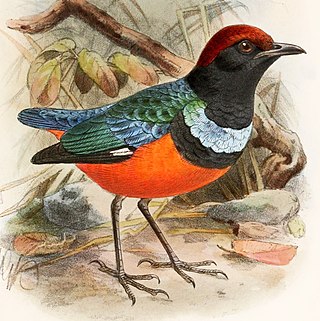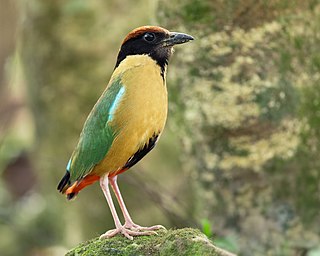
The green broadbill also known as the lesser green broadbill is a small bird in the family Calyptomenidae. It was formerly classified in the family Eurylaimidae, a group of closely related birds that share the name "broadbill".

The superb pitta is a large pitta that is endemic to Manus Island which lies to the north of Papua New Guinea.

The rainbow pitta is a small passerine bird in the pitta family, Pittidae, endemic to northern Australia, most closely related to the superb pitta of Manus Island. It has a velvet black head with chestnut stripes above the eyes, olive green upper parts, black underparts, a bright red belly and an olive green tail. An Australian endemic, it lives in the monsoon forests and in some drier eucalypt forests.

The pitta-like ground roller is a species of bird in the ground roller family Brachypteraciidae. The species is monotypic, having no subspecies. It is endemic to Madagascar.

The Sula pitta is a species of the pitta. It was considered a subspecies of the red-bellied pitta. It is endemic to Indonesia where it occurs in the Sula and Banggai Islands. Its natural habitat is subtropical or tropical moist lowland forests. It is threatened by habitat loss.

The elegant pitta is a species of passerine bird in the pitta family Pittidae. It is endemic to Indonesia, where it is found in the Lesser Sunda Islands and Moluccas.

The Philippine pitta or blue-breasted pitta, is a species of bird in the family Pittidae. It has a pointed beak and has a red belly with a green blue band above. It is found in Indonesia and the Philippines. Its natural habitat is subtropical or tropical moist lowland forest. It was considered the nominate subspecies of the red-bellied pitta. This species has a wingspan of 20 – 25 cm and is 17.5 – 20 cm tall. In the class Aves it lays eggs and has feathers covering its entire body, it also has wings and can fly. As the illustration on your right shows it has short tail feathers and has a small brown head.

The ivory-breasted pitta is a species of bird in the family Pittidae. It is endemic to North Maluku in Indonesia, known as Paok halmahera. Its natural habitat is subtropical or tropical moist lowland forests.

The mangrove pitta is a species of passerine bird in the family Pittidae native to the eastern Indian Subcontinent and western Southeast Asia. It is part of a superspecies where it is placed with the Indian pitta, the fairy pitta and the blue-winged pitta but has no recognized subspecies. A colourful bird, it has a black head with brown crown, white throat, greenish upper parts, buff underparts and reddish vent area. Its range extends from India to Malaysia and Indonesia. It is found in mangrove and nipa palm forests where it feeds on crustaceans, mollusks and insects. Its call, sometimes rendered as wieuw-wieuw, is sung from a high perch on a mangrove tree.

The blue-rumped pitta is a species of bird in the family Pittidae. It is found in Cambodia, China, Laos, Thailand, and Vietnam. Its natural habitats are subtropical or tropical moist lowland forest and subtropical or tropical moist montane forest.

The azure-breasted pitta is a species of bird in the family Pittidae. It is a striking and colorful bird having colors of red, azure, green, black and white, It is endemic to the islands of Mindanao, Bohol, Leyte and Samar in the Philippines. Its natural habitat is tropical moist lowland forest. It is threatened by habitat loss.

The noisy pitta is a species of bird in the family Pittidae. The noisy pitta is found in eastern Australia and southern New Guinea. It eats earthworms, insects and snails. Its natural habitats are temperate forests, subtropical or tropical moist lowland forest, and subtropical or tropical moist montane forest.

The Sulawesi pitta is a species of pitta. It was considered a subspecies of the red-bellied pitta. It is endemic to Indonesia where it occurs in Sulawesi, Manterawu, and Togian Islands. Its natural habitat is subtropical or tropical moist lowland forest. It is threatened by habitat loss.

The Siau pitta or Siao pitta is a species of the pitta. It was considered a subspecies of the red-bellied pitta. It is endemic to Indonesia where it occurs in Siau and Tagulandang. Its natural habitat is subtropical or tropical moist lowland forests. It is threatened by habitat loss.

The Sangihe pitta is a species of the pitta. It was considered a subspecies of the red-bellied pitta. It is endemic to Indonesia where it occurs in the Sangihe Islands. Its natural habitat is subtropical or tropical moist lowland forests. It is threatened by habitat loss.
The South Moluccan pitta is a species of pitta. It was formerly considered a subspecies of the red-bellied pitta. It is endemic to Indonesia where it occurs on Buru and Seram. Its natural habitat is subtropical or tropical moist lowland forests. It is threatened by habitat loss.

The North Moluccan pitta is a species of the pitta. It was considered a subspecies of the red-bellied pitta. It is endemic to Indonesia where it occurs on the northern Moluccas. Its natural habitat is subtropical or tropical moist lowland forests. It is threatened by habitat loss.
The Louisiade pitta is a species of the pitta. It was considered a subspecies of the red-bellied pitta. It is endemic to Rossel Island in the Louisiade Archipelago in Papua New Guinea. Its natural habitat is subtropical or tropical moist lowland forests. It may be threatened by habitat loss, but is currently listed by the IUCN as Data Deficient as there have been no definite records since the type specimen was collected in 1898. However an expedition to the island in 2014 revealed that local people said they still encountered it.

The Papuan pitta is a species of pitta. It was formerly considered a subspecies of the red-bellied pitta. It is found in the Aru Islands, New Guinea and the northern Cape York Peninsula. Its natural habitat is subtropical or tropical moist lowland forest. It is threatened by habitat loss.
The Tabar pitta is a species of the pitta bird. It was considered a subspecies of the Bismarck pitta, and some taxonomic authorities still consider it so. It is endemic to the Tabar Group in Papua New Guinea. Its natural habitat is subtropical or tropical moist lowland forests. It is threatened by habitat loss.


















